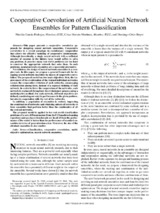Mostrar el registro sencillo del ítem
Cooperative coevolution of artificial neural network ensembles for pattern classification
| dc.contributor.author | Ortiz-Boyer, Domingo | es_ES |
| dc.contributor.author | Hervás-Martínez, César | es_ES |
| dc.contributor.author | García-Pedrajas, Nicolás | es_ES |
| dc.date.accessioned | 2010-12-29T10:10:12Z | |
| dc.date.available | 2010-12-29T10:10:12Z | |
| dc.date.issued | 2005 | |
| dc.identifier.issn | 1089-778X | |
| dc.identifier.uri | http://hdl.handle.net/10396/3963 | |
| dc.description.abstract | This paper presents a cooperative coevolutive approach for designing neural network ensembles. Cooperative coevolution is a recent paradigm in evolutionary computation that allows the effective modeling of cooperative environments. Although theoretically, a single neural network with a sufficient number of neurons in the hidden layer would suffice to solve any problem, in practice many real-world problems are too hard to construct the appropriate network that solve them. In such problems, neural network ensembles are a successful alternative. Nevertheless, the design of neural network ensembles is a complex task. In this paper, we propose a general framework for designing neural network ensembles by means of cooperative coevolution. The proposed model has two main objectives: first, the improvement of the combination of the trained individual networks; second, the cooperative evolution of such networks, encouraging collaboration among them, instead of a separate training of each network. In order to favor the cooperation of the networks, each network is evaluated throughout the evolutionary process using a multiobjective method. For each network, different objectives are defined, considering not only its performance in the given problem, but also its cooperation with the rest of the networks. In addition, a population of ensembles is evolved, improving the combination of networks and obtaining subsets of networks to form ensembles that perform better than the combination of all the evolved networks. The proposed model is applied to ten real-world classification problems of a very different nature from the UCI machine learning repository and proben1 benchmark set. In all of them the performance of the model is better than the performance of standard ensembles in terms of generalization error. Moreover, the size of the obtained ensembles is also smaller. | en |
| dc.format.mimetype | application/pdf | es_ES |
| dc.language.iso | eng | es_ES |
| dc.publisher | IEEE | en |
| dc.rights | https://creativecommons.org/licenses/by-nc-nd/4.0/ | es_ES |
| dc.source | Ieee Transactions on Evolutionary Computation 9 (3), 271-302 (2005) | es_ES |
| dc.subject | Neural Network Ensembles | en |
| dc.subject | Multiobjective Optimization | en |
| dc.subject | Multiobjective Evolutionary Algorithms | en |
| dc.subject | Combining Classifiers | en |
| dc.subject | Cooperative Coevolution | en |
| dc.title | Cooperative coevolution of artificial neural network ensembles for pattern classification | en |
| dc.type | info:eu-repo/semantics/article | es_ES |
| dc.rights.accessRights | info:eu-repo/semantics/openAccess | es_ES |

